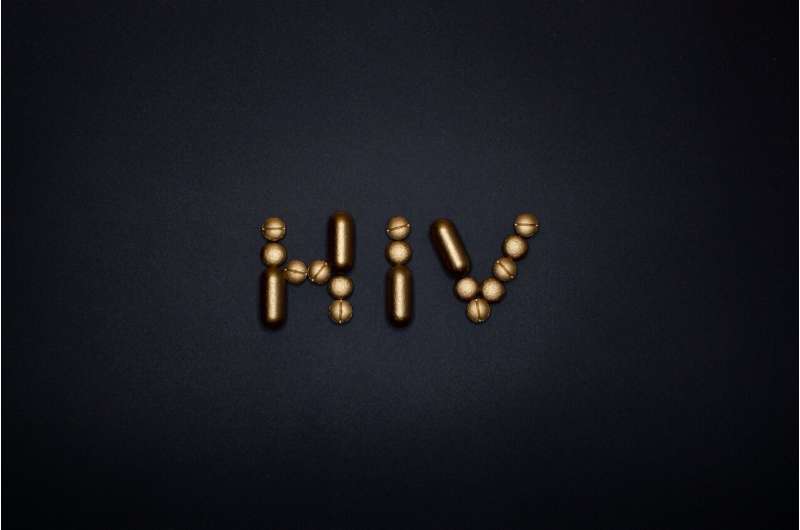This article has been reviewed according to Science X's editorial process and policies. Editors have highlighted the following attributes while ensuring the content's credibility:
fact-checked
peer-reviewed publication
trusted source
proofread
Drug candidate may 'unmask' latent HIV-infected cells, mark them for destruction

University of Pittsburgh School of Medicine scientists have identified drug candidates that show promise to reverse the ability of HIV to escape detection by the immune system.
The discovery, described in Cell Chemical Biology, reveals a potential path to eliminate the viral reservoir that cannot be cleared with existing antiretroviral drugs. This reservoir is what prevents people from being completely cured of HIV even when their viral load is undetectable in standard tests.
"We have excellent antiretroviral drugs that suppress HIV, but unfortunately, none of them clear the virus. If someone with HIV stops taking their medication, the infection will rebound," said senior author Thomas Smithgall, Ph.D., the William S. McEllroy Professor and former chair of the Pitt School of Medicine's Department of Microbiology and Molecular Genetics.
"HIV establishes a reservoir of infected cells that lay dormant even in the presence of antiretroviral therapy, hiding from immune system detection. We think we've uncovered a key to unmasking that reservoir."
The research centers on HIV Nef, a viral protein expressed at high levels after HIV infection. Over the past three decades, Smithgall's team and others have shown that Nef can prevent the immune system from destroying infected cells by blocking or "hiding" signs of the virus on the cell surface. But unlike other HIV proteins that are expressed during infection, Nef is a challenging target for drug design.
"A protein like Nef is often considered undruggable because it doesn't have a defined binding site for drug action," said lead author Lori Emert-Sedlak, Ph.D., research associate professor of microbiology and molecular genetics at Pitt. "Our existing Nef inhibitors, which only bind to Nef, block some Nef functions extremely well, but don't touch other functions, many of which are critical for HIV infection."
So the research team took a different approach. Rather than pursuing a drug molecule that might only block one or two Nef functions, they looked for a compound that would mark it for degradation in infected cells. Degrading the Nef protein would block all of its functions, including HIV infection and replication. In addition, HIV antigens would be restored to the surface of infected cells, revealing them to the immune system for destruction.
Working in collaboration with co-author Colin Tice, Ph.D., a senior research chemist at the biotechnology company Fox Chase Therapeutics Discovery, Inc. (FCTDI), the team first identified small molecules that bind to the Nef protein. These Nef binders were then coupled to a second molecule that marks the Nef protein for destruction by a natural cellular process.
The resulting drug candidates—called proteolysis targeting chimeras, or PROTACs—triggered Nef degradation, which suppressed HIV replication in target cells and showed signs that the immune response could be restored.
"In general, the PROTAC approach has generated a great deal of excitement at drug companies, but they've been almost entirely targeted to proteins involved in cancers," Smithgall said. "Our Nef-directed PROTACs are one of the first examples targeting infectious diseases. In theory, this approach should be applicable to proteins from other viruses that serve functions similar to HIV Nef."
While Smithgall said he is excited for the potential of Nef PROTACs to someday treat HIV infections, he cautioned that several major steps are still required before they can be tested in people. His team will simultaneously pursue preclinical testing in animal models, mapping of the Nef signaling pathways to learn exactly how the PROTACs are working in cells and using advanced crystallography tools to determine the structure of the Nef protein in complex with the PROTAC molecule and the cellular machinery responsible for its degradation.
"Finding a small molecule that bound selectively to Nef, that was the hardest part," Smithgall said. "Now we have to keep going with medicinal chemistry optimization and see how well it works against the HIV reservoir in an animal model."
More information: PROTAC-mediated Degradation of HIV-1 Nef Efficiently Restores Cell-surface CD4 and MHC-I Expression and Blocks HIV-1 Replication, Cell Chemical Biology (2024). DOI: 10.1016/j.chembiol.2024.02.004. www.cell.com/cell-chemical-bio … 2451-9456(24)00078-3




















